Spring Season 2020 Overview
And…it’s over. All in all, we were lucky to have so many series still streaming, as several fell by the wayside due to Covid-19 and were postponed until the Summer and Autumn Seasons. But how did the titles that our team at Anime UK News chose to cover turn out in the end? Did they live up to the promise of their opening episodes…or did they run out of steam and/or resources? Has it been – in spite of everything – a memorable season?
Demelza
In spite of everything, I think this has been a memorable season. While a number of shows I was watching did get delayed into next season, the majority went ahead undisturbed and ended up being some of the best anime available.
When we wrote our Spring Season 2020 Preview article a couple of months ago my first pick was Kakushigoto, a comedy series following a manga author who was trying desperately to keep his work a secret from his young daughter. Even just three episodes into the show I’d completely fallen in love with it, but I did have one minor concern.
While I admired Kakushigoto for trying to tell two stories, one in the past and one in the present. I was worried that the present day story was both unnecessary and likely to go unresolved since the manga was at the time still on-going. With news that the manga would be ending in July, I got more hopeful that the anime would adapt the story to the end. While it’s too early to tell if the anime matches the ending of the manga, it certainly brought the tale to an emotional and satisfying conclusion.
In the end Kakushigoto delivered a wonderful family comedy that was full of fun. Be it because of the jokes revolving around working in the manga industry or simply about raising a child, the series always left me with a big smile on my face and wondering what was going to happen next. Perhaps it’s too early to call it my Anime of The Year with still half the year left to go, but I think other shows are going to struggle to topple it.
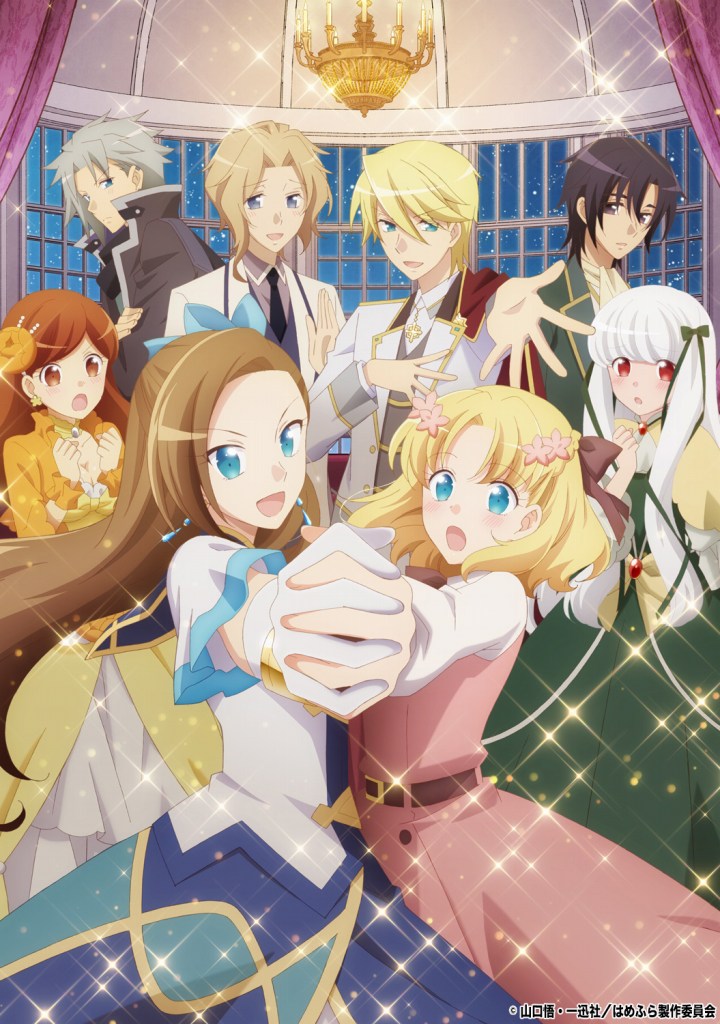
My other pick for this season was My Next Life as a Villainess: All Routes Lead to Doom!, which is an adaption of an on-going light novel series. I’ve had mixed feelings on the light novels, due to some recycled plot points and wonky writing, but thankfully the anime has so far only adapted the best bits of the series!
With animation by Silver Link and a collection of popular voice actors, this is one of the better light novel adaptions lately. It focuses on the first two novels and even includes some anime-original content that captures the cast and their crazy antics incredibly well.
While My Next Life as a Villainess never truly concludes Katarina’s tale (although it does get to the end of all her ‘Bad Ends’) or puts her with any particular love interest, none of this matters too much. Ultimately this anime is about experiencing Katarina’s day to day life and that is great fun. She remains completely oblivious to the affection of those around her and as they bicker among themselves to win her love, we get to enjoy seeing both sides of the story. I also love the fact that Katarina not only wins over all the male characters but also her female friends as well, meaning viewers have a lot of ships to choose from.
As far as harem series go, My Next Life as a Villainess: All Routes Lead to Doom! brought something new to the table. Even if you’re not usually a harem fan I think you’ll enjoy watching the antics of this lovable cast as they spend their days in relative peace and quiet. Also if you’re eager to experience more of Katarina’s life in anime form then you’ll be pleased to know that a second season is currently scheduled for release next year!
Kakushigoto is streaming on Funimation, whereas My Next Life as a Villainess is available on Crunchyroll.
HWR
Though I wouldn’t say this season has given way to many truly great anime, revisiting my choices from the preview article has reaped very pleasant results!

Wave, Listen to Me! engaged me thanks to its premise and sold me after spending a few episodes with central protagonist Minare, a loveable yet flawed adult trying to find their way in life.
As the series progressed it really let its surreal side shine through with scenarios like a creepy pasta-style misunderstanding involving a neighbour and a mysterious red liquid leaking from the ceiling, or the ever-riveting radio drama that Minare takes us through. The sometimes dark humour gives the proceedings a unique edge to accompany the likeable cast of characters and by the end of the final episode I was keen to see more.
Princess Connect Re:Dive, meanwhile, doesn’t exactly offer as much in terms of deeper storytelling but has a real sense of fun and humour that made for some warm and comfy viewing every Monday.
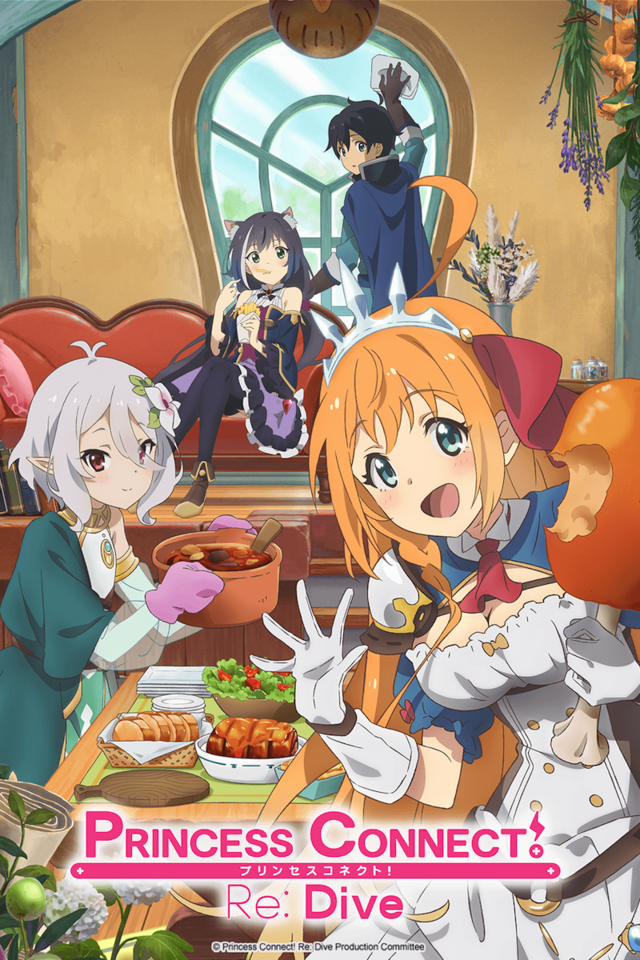
Previously I had discussed the likeable Kokkoro (and the plentiful number of x style faces), who is accompanied by the simple but endearing Yuuki and food-enthusiast Pecorine (whose schemes have a tendency to put the group in unnecessary danger.) By the end of the series, tsundere catgirl Kyaru is fully integrated into the unit, and the supporting characters met along the way were also fun additions.
I did appreciate that there were elements of deeper goings-on within the world and the dynamic between the central cast never wore itself out. In a season where several titles left me decidedly unenthused, Princess Connect Re:Dive offered an easy watch each week that, though not challenging, has that sense of fun I love in anime.
Some honourable mentions from me go to Sakura Wars: The Animation, which despite a lacklustre final few episodes was fun and gave some incentive to check out the recent game. I’ll also give praise to Ascendance of a Bookworm Part 2, which offered a strong second season that cemented itself as a recent favourite from the genre.
Wave, Listen to Me! Is available to stream on Funimation whilst Princess Connect! Re:Dive is available to stream on Crunchyroll.
Onosume
Despite many series receiving delays due to the ongoing global situation, I have to agree it has still been a pretty good season overall. While I am still waiting for two of my spring season picks to resume – APPARE-RANMAN! and Gal & Dino – I’ve at least had the second season of Kaguya-sama: Love is War to thoroughly howl at every week, which has proved to be just as funny and enjoyable as its first season.

While the main focus is still on Kaguya and Miyuki’s prideful battle of wits to get the other to confess, at its heart the series is just an immensely fun gag comedy about a bunch of idiots who run the student council (although they don’t ever seem to do much student council work), and it’s just a riot witnessing all their daft interactions. Chika is still probably the best character in the series as she’s still bursting in at inappropriate moments and driving a lot of the comedy, however this season does a good job of showing us more of Kaguya’s rather fragile mental state as she’s clearly going crazy lusting after Miyuki, while there’s also plenty of time spent on Ishigami, who is a lot more involved this season and gets an… interesting arc of his own. While the dark twist sure was a curveball and felt very out of place with the rest of the series, I did appreciate the deep dive into his character, which fleshes him out nicely.
We also get introduced to two new members of the cast with the student council elections: presidential candidate Miko Ino and her friend in the school’s disciplinary committee, Kobachi Osaragi. While still entertaining, I felt the election dragged on just a little too long; and despite the end result, Miko still feels more of a side character throughout the rest of the series, somewhat similar to Ishigami’s presence in the first season. I was hoping she’d bring some fresh air into the existing cast, but apart from the gags around her misunderstandings, she hasn’t yet had a chance to bring much to the table.
With a series such as this there is always the fear it is going to grow stale quickly, so it’s definitely an achievement that it hasn’t done so yet; and with the manga still ongoing there’s plenty of material still to cover. I’d certainly be up for more, as it’s one of the most genuinely funny series I’ve seen for some time, and I can’t recommend it enough.

Anime adaptations of video games always seem to be very much hit-and-miss; either being a faithful adaptation or falling short of the mark, so I always approach them with caution. With Sakura Wars: The Animation however, no caution was needed as despite knowing very little about the games, this one came out as a surprise hit.
While attached to the Sakura Wars franchise as a follow-up to the 2019 game, I was pleasantly surprised to find that you don’t really need to know much about the world or characters beforehand, as it works absolutely fine standing on its own, with the setup at the beginning being clearly communicated. After the destruction of the Moscow Imperial Combat Revue, the only survivor, a young girl named Klara, is rescued by a mysterious masked hero and whisked away safely to Tokyo, where she is inducted into the Imperial Combat Revue’s Flower Division – an all-female theatre troupe who also wield powerful mechs to protect the city from rampaging demons. When the newly appointed leader of the Moscow Imperial Combat Revue, Valery Kaminsky, shows up and demands Klara’s return, it’s clear that something isn’t right – so the Flower Division decide to protect Klara as they face down both Kaminsky and a new onslaught of demons.
While the plot can be very predictable and Kaminsky doesn’t offer anything new as a villain, it’s still really fun to watch with a lovable core cast of characters, decent action sequences and good world building. It has some interesting themes around how the demons are treated by different groups of people, from tools of war to being just like us; while the whole mystery surrounding Klara was fun to watch unravel, even though it does start to become quite easy to figure out as the show goes on. It generally looks good too – with this being a Sanzigen production there is a lot of CGI work, and although character movements can look a little stiff at times, they continue to show that they are one of the few Japanese animation studios that can handle CGI well.
While this one may certainly appeal more to fans of the game series, don’t let this one pass you by even if you are not, as it is fun, playful and thrilling to watch.
Both Kaguya-sama: Love is War Season 2 and Sakura Wars: The Animation are available to stream via Funimation.
Josh A. Stevens
One thing I’ve learned the hard way in my years of watching anime, is no matter how strong a debut a series has, it can always lose its way. I still consider the premiere episode of 2016’s Izetta: The Last Witch to be the best single episode of anime I’ve seen after Violet Evergarden, yet the overall series dipped enough for me to rate it a generous 7/10 on MyAnimeList. Four years later, I’ve had a similar experience with a series that I was really excited about back in our preview, but rushed to the finish line too fast, at the cost of its characters’ narrative arcs.
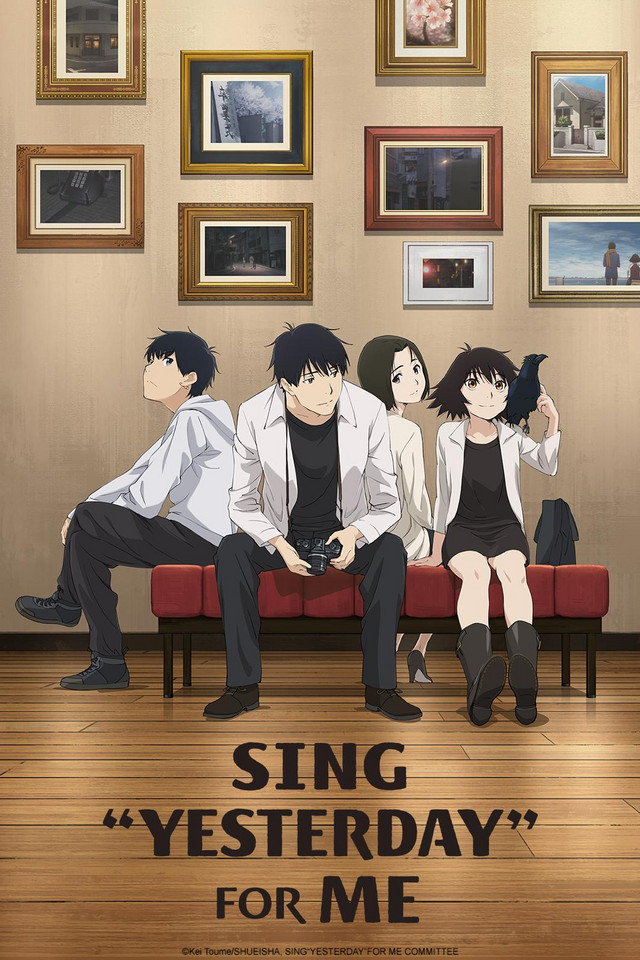
Sing “Yesterday” For Me started off really strong, introducing its four main characters at different stages of discontent with young adult life: Rikuo is a recent graduate stuck in a part-time job, Shinako is still grieving over her childhood crush, and said crush’s little brother Rō who wants Shinako to see him as a man. There’s also the cheerful drop-out Haru, who has a crow on her shoulder, some family issues, and a crush on Rikuo. Each character had the potential to overcome their faults and grow into more fulfilled people, but Sing “Yesterday” For Me clearly faced a dilemma of how to deliver that once its cast started mixing together. It’s totally fine, and arguably more realistic, for some characters who try to give up or fail (which I’ll be exploring in a separate feature to come), but regardless of how a series or a narrative arc ends, it has to feel earned. Here, it didn’t.
I must confess that I have not read the Sing “Yesterday” For Me manga, because as of writing, it remains unlicensed. People whom I have spoken with, however, have commented that the anime’s last leg essentially skips four volumes worth of material that helps contextualise decisions made in the ending. Without that extra nuance, it feels like the anime team just decided to bin some characters’ development to shoe-horn hasty conclusions for others, while rewarding the more toxic aspects of the series. It’s a shame that a mistranslation led people to believe there were 6 OVA episodes coming, because they would have been more than welcome. An ending to a series shouldn’t shape my overall opinion of a series, but Sing “Yesterday” For Me left such a bad taste in my mouth after such a strong first impression, that to quote my Mum: “I’m not angry, just disappointed”.

I had more fun with Tower of God though, despite faults like the series suddenly questioning what it actually wants to be. After opening episodes that established how people will do anything to climb the mysterious tower with challenges that outright encouraged competitors to kill each other en masse, the series pulls a sudden 180° turn into a school-like setting, where even the test’s administrators lament students killing each other as a horrible and sad thing (although there’s still dark threads weaving in the background). I found the change jarring at first, but once it settled into this new stride, I had a great time with it.
The strength of Tower of God isn’t in its narrative, which still feels like it’s taking baby steps towards an inciting incident that concludes the series, but in its characters. In our preview, I praised the quirky and colourful character designs that range from the green, lizard-like best girl Anaak, to a dude who’s snuggly-wrapped in a blanket most of the time. When they take time out from trying to kill each other to sit around a table, however, I realised that their personalities are just as vivid and charming as their designs (or more so, in the case of the charismatic Endorsi). Tower of God shines so brightly with its cast that I could easily say it was the series I enjoyed the most this season, even though I came out of it knowing just as little about the tower as I did going in. The action can be gripping at times too, such as watching Anaak go on a rampage with her whip-like sword, or Khun’s intricate strategies unfold. In terms of the production, Kevin Penkin’s score adds a magical, fantastical quality that really elevates the series, and the always-wonderful Saori Hayama delivers a stand-out performance as Rachel. In a nutshell, I enjoy Tower of God in a similar way to Sword Art Online – you don’t need to take it too seriously, and just have fun with it.
The double-edged sword of adapting an ongoing WebToon, though, is that the Tower of God anime doesn’t get to answer most of the questions or resolve the conflicts it poses, but has left me wanting more. So please Crunchyroll, if you’re reading this, announce a second season! It really needs one after how it ended! Until then, I guess I’ll have to read the WebToon…
Both Tower of God and Sing “Yesterday” for Me are available for streaming on Crunchyroll.
Sarah

In spite of many series falling by the wayside, this has proved to be a surprisingly strong and varied season. Thank goodness, during the gloom of lockdown, then, for the mischievous humour of Kaguya-san whose second season proved just as wickedly enjoyable as the first, possibly taking the prize for the best OP – and the antics of Katarina Klaes, reborn into an otome game she once played and realizing that she’s the villainess (see Demelza’s thoughts above). Best anime for me was Kakushigoto (another contender for best OP of the season, and best ED too) also covered for us here by Demelza – which charmed and amused and touched the heart in equal measure. Magical animation for both OP and ED matched the chosen songs and the series so well! But I’m here to talk about the second season of Fruits Basket which is now dramatizing the later volumes of the manga and has entered the territory that wasn’t covered by the original TV anime. The cast is now so large that schoolgirl heroine Tohru and the little household run by Shigure Soma that she has become an integral part of are sometimes absent from whole episodes or only glimpsed on the periphery. As we get to see more of Akito, the young head of the Soma household – and their cruel and unhealthy attitude to the others who are possessed/cursed by spirits of the animals of the Zodiac – we see how far the reality of the benign god inviting the twelve creatures to dinner has warped over time and become corrupted by the curse. Akito is no benevolent kami – but needy, self-centred and abusive. What has made them become this way? We haven’t yet discovered – but a crucial meeting while everyone is at the beach for the summer break – pits Akito against Tohru. During the holiday, Akito has been holding court at another holiday home close by, heightening and reinforcing the insecurities the Soma young people feel about themselves. Monster-possessed Kyo is told he will be locked away, like his grandfather, for life. Yet when the Soma children return to the other house, there’s Tohru, ready to welcome and reassure them – and suddenly, Akito’s stranglehold seems to be weakening. Just a little.
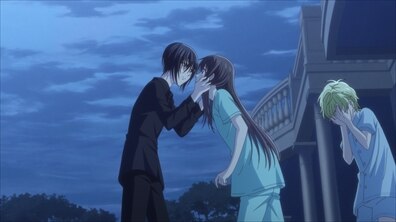
Many of these episodes have brought out the qualities that make the original manga so gripping: the poisonous atmosphere within the Soma clan and its ancient hierarchy, contrasted with Tohru’s good influence. This doesn’t work if Tohru is just depicted as a sweet-natured airhead – fortunately the series has spent time in showing us her loving relationship with her mother, the onetime girl gang leader, so when Tohru stands up to Akito in her own quiet way, you fear for her – but you’re also cheering her on. Where the series (and the manga) is less successful is spending so much time on Yuki’s problems with the school student council (he’s the new president). Creating irritating characters (Treasurer Kakeru) is a challenge that the mangaka never quite solved – and although getting along with Kakeru and Machi is supposed to show Yuki’s growth as a person, I’ve never been convinced. We’ll see… Great performances, though, by the Japanese voice actors.
Fruits Basket is continuing into the Summer Season – and there are whispers that there might be a Third Season, unconfirmed at this stage. But my other series, Woodpecker Detective’s Office, has concluded at twelve episodes.
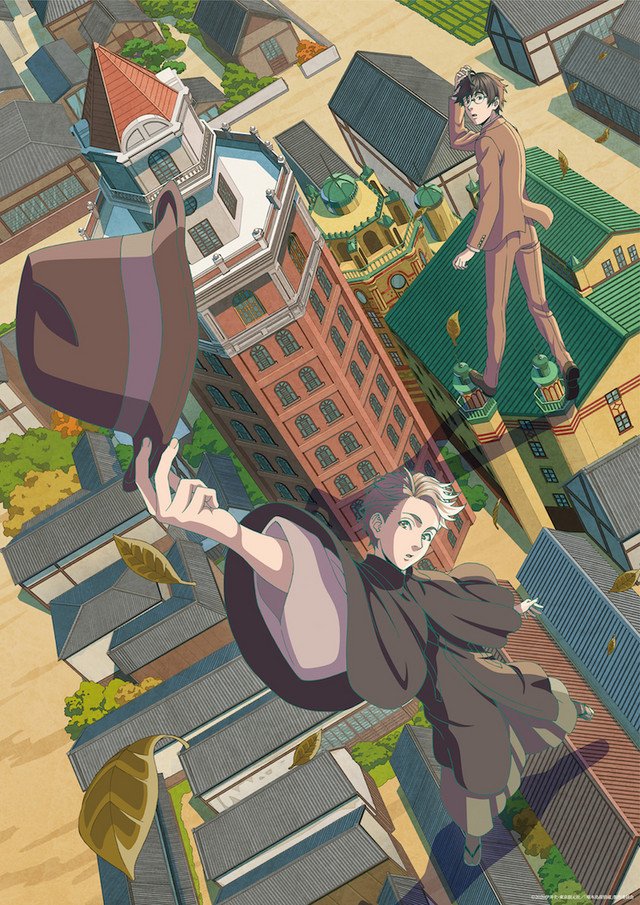
This atmospheric Meiji-era series introduced us to many of the writers we recognize from Bungo Stray Dogs and Bungo and Alchemist but without any superpowers – other than that of their pens. Focusing on young poet Ishikawa Takuboku and his long-suffering friend, kind-hearted academic Kindaichi Kyosuke, we know from the start that Ishikawa is not long for this world (he has TB). However, his indomitable spirit, aggressively cheerful smile and infuriating habit of mooching off his equally impoverished friends lead him to establish the Woodpecker Detective Agency, involving the other writers to help him with his investigations. The crime-solving is not presented in a typical ‘murder of the week’ manner; the investigations are woven in with the inevitable disintegration of Takuboku’s health and ability to write. The ravages of the illness, portrayed by his increasingly (and shockingly) gaunt face and coughing up of blood, are contrasted by his dogged determination to keep going and solve a crime that relates to a woman he loved. If this sounds grim watching, it is, in a way – and yet his puckish spirit (brilliantly conveyed in the lively OP with its upbeat jazzy song and attractive, clever imagery) makes the viewer want to see things through to the end with the faithful Kindaichi. Takuboku’s not always a likable protagonist but his will to live for as long as he can is admirable. (The ED is the Gondola Song, dating from the Taisho era – 1915 – and made famous in Kurosawa’s 1952 film Ikiru about a dying salaryman. Here it’s given a 21st century musical re-interpretation with some of the most pretty ‘period’ artwork I’ve seen this season.) With mysteries to solve such as “The ghosts of the Twelve-Story Tower in Asakusa” and “The man-eating figure who wanders the streets on snowy nights” there are elements of a crime-solving adventure but there’s also literary discussion about writing (poetry and fiction!) among the impoverished writers as they drink sake. This is not a series for everyone – it really is anime for grown-ups as there are no happy endings, the crimes are realistically portrayed and there’s no sugar-coating of the grim realities of life in the early twentieth century, especially for women. However, the warmth of Kindaichi’s friendship is conveyed and the ending is genuinely moving.
Woodpecker Detective’s Office and Fruits Basket Season 2 are currently streaming on Crunchyroll (Fruits Basket is also streaming dubbed on Funimation).


